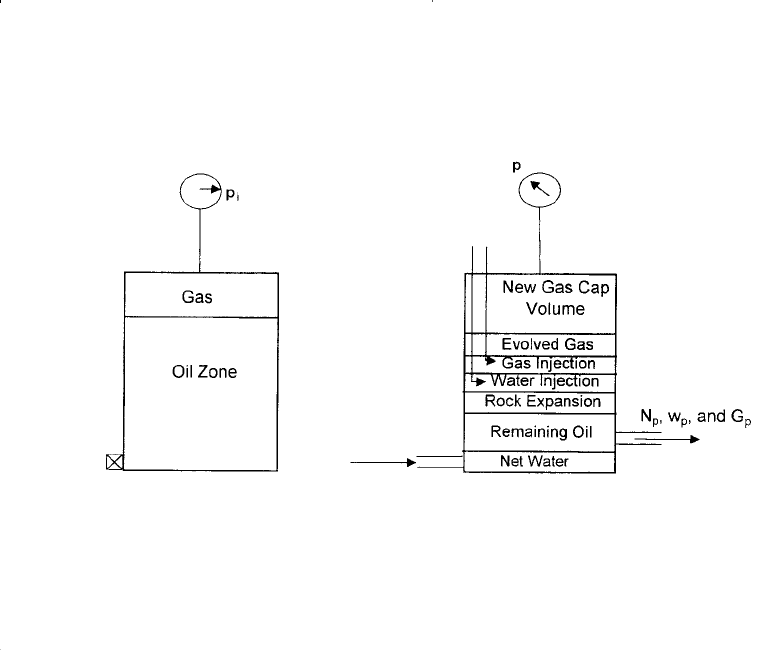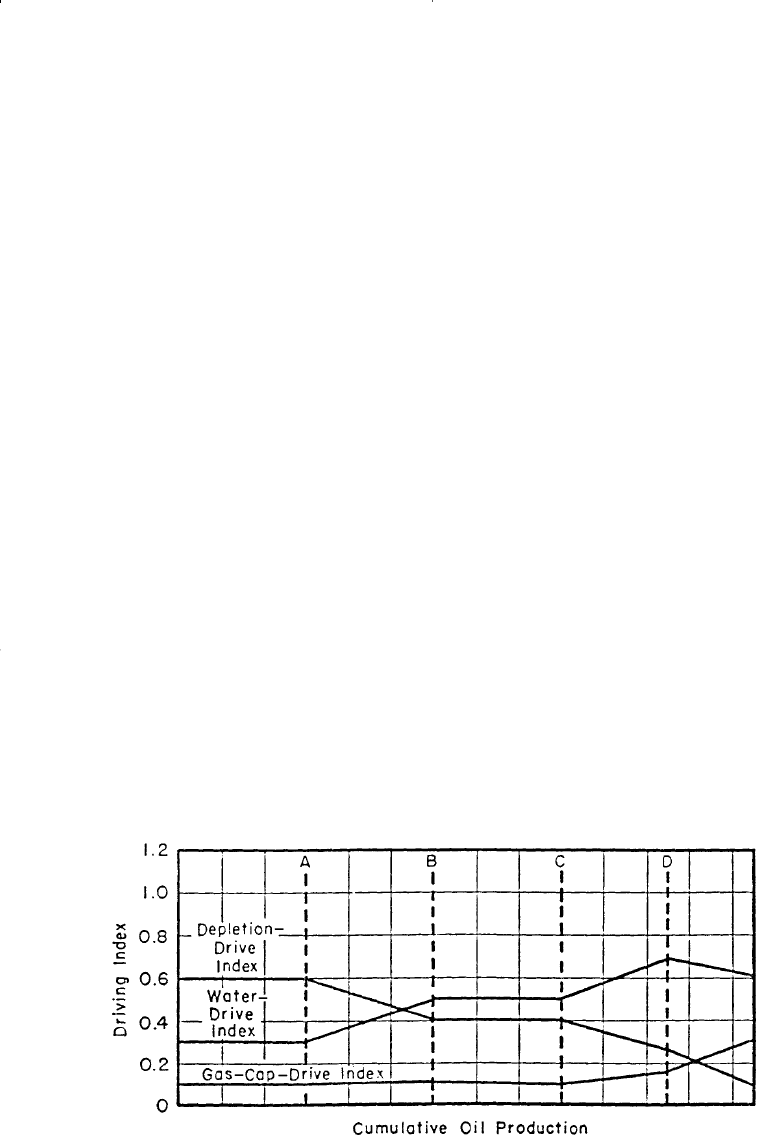Tarek Ahmed. Reservoir engineering handbook
Подождите немного. Документ загружается.


derived by conveniently introducing the parameter m into the relation-
ship as follows:
Defining the ratio m as:
Solving for the volume of the gas cap gives:
Initial volume of the gas cap = G B
gi
= m N B
oi
The total volume of the hydrocarbon system is then given by:
Initial oil volume + initial gas cap volume = (P.V) (1 − S
wi
)
N B
oi
+ m N B
oi
= (P.V) (1 − S
wi
)
or
where S
wi
= initial water saturation
N = initial oil in place, STB
P.V = total pore volume, bbl
m = ratio of initial gas-cap-gas reservoir volume to initial
reservoir oil volume, bbl/bbl
Treating the reservoir pore as an idealized container as illustrated in
Figure 11-14, volumetric balance expressions can be derived to account
for all volumetric changes which occurs during the natural productive
life of the reservoir.
The MBE can be written in a generalized form as follows:
Pore volume occupied by the oil initially in place at p
i
+
Pore volume occupied by the gas in the gas cap at p
i
=
Pore volume occupied by the remaining oil at p
PV
NB m
S
oi
wi
.
()
=
+
−
1
1
(11-1)
m
Initial volume of gas cap
Volume of oil initially in place
GB
NB
gi
oi
==
738 Reservoir Engineering Handbook
Reservoir Eng Hndbk Ch 11 2001-10-25 15:59 Page 738

+
Pore volume occupied by the gas in the gas cap at p
+
Pore volume occupied by the evolved solution gas at p
+
Pore volume occupied by the net water influx at p
+
Change in pore volume due to connate water expansion and pore
volume reduction due to rock expansion
+
Pore volume occupied by the injected gas at p
+
Pore volume occupied by the injected water at p (11-2)
The above nine terms composing the MBE can be separately deter-
mined from the hydrocarbon PVT and rock properties, as follows:
Pore Volume Occupied by the Oil Initially in Place
Volume occupied by initial oil in place = N B
oi
(11-3)
where N = oil initially in place, STB
B
oi
= oil formation volume factor at initial reservoir pressure p
i
,
bbl/STB
Oil Recovery Mechanisms and the Material Balance Equation 739
Figure 11-14. Tank-model concept.
Reservoir Eng Hndbk Ch 11 2001-10-25 15:59 Page 739

Pore Volume Occupied by the Gas in the Gas Cap
Volume of gas cap = m N B
oi
(11-4)
where m is a dimensionless parameter and defined as the ratio of gas-cap
volume to the oil zone volume.
Pore Volume Occupied by the Remaining Oil
Volume of the remaining oil = (N − N
p
) B
o
(11-5)
where N
p
= cumulative oil production, STB
B
o
= oil formation volume factor at reservoir pressure p, bbl/STB
Pore Volume Occupied by the Gas Cap at Reservoir Pressure p
As the reservoir pressure drops to a new level p, the gas in the gas cap
expands and occupies a larger volume. Assuming no gas is produced
from the gas cap during the pressure decline, the new volume of the gas
cap can be determined as:
where B
gi
= gas formation volume factor at initial reservoir pressure,
bbl/scf
B
g
= current gas formation volume factor, bbl/scf
Pore Volume Occupied by the Evolved Solution Gas
This volumetric term can be determined by applying the following
material balance on the solution gas:
volume of the evolved
solution gas
volume of gas initially
in solution
volume of gas
produced
volume of gas
remaining in solution
=
−
−
Volume of the gas cap at p =
mNB
B
B (11- 6)
oi
gi
g
740 Reservoir Engineering Handbook
Reservoir Eng Hndbk Ch 11 2001-10-25 15:59 Page 740

where N
p
= cumulative oil produced, STB
R
p
= net cumulative produced gas-oil ratio, scf/STB
R
s
= current gas solubility factor, scf/STB
B
g
= current gas formation volume factor, bbl/scf
R
si
= gas solubility at initial reservoir pressure, scf/STB
Pore Volume Occupied by the Net Water Influx
net water influx = W
e
− W
p
B
w
(11-8)
where W
e
= cumulative water influx, bbl
W
p
= cumulative water produced, STB
B
w
= water formation volume factor, bbl/STB
Change in Pore Volume Due to Initial Water and
Rock Expansion
The component describing the reduction in the hydrocarbon pore vol-
ume due to the expansion of initial (connate) water and the reservoir rock
cannot be neglected for an undersaturated oil reservoir. The water com-
pressibility c
w
and rock compressibility c
f
are generally of the same order
of magnitude as the compressibility of the oil. The effect of these two
components, however, can be generally neglected for gas-cap-drive reser-
voir or when the reservoir pressure drops below the bubble-point pressure.
The compressibility coefficient c which describes the changes in the
volume (expansion) of the fluid or material with changing pressure is
given by:
or
∆∆VVcp=
c
V
V
p
=
−∂
∂
1
or
volume of the evolved
solution gas
(11- 7)
=−−−[()]NR N R N N R B
si p p p s g
Oil Recovery Mechanisms and the Material Balance Equation 741
Reservoir Eng Hndbk Ch 11 2001-10-25 15:59 Page 741

where ∆V represents the net changes or expansion of the material as a
result of changes in the pressure. Therefore, the reduction in the pore vol-
ume due to the expansion of the connate water in the oil zone and the gas
cap is given by:
Connate water expansion = [(pore volume) S
wi
] c
w
∆p
Substituting for the pore volume (P.V) with Equation 11-1 gives:
where ∆p = change in reservoir pressure, (p
i
− p)
c
w
= water compressibility coefficient, psi
−1
m = ratio of the volume of the gas-cap gas to the reservoir oil
volume, bbl/bbl
Similarly, the reduction in the pore volume due to the expansion of the
reservoir rock is given by:
Combining the expansions of the connate water and formation as rep-
resented by Equations 11-9 and 11-10 gives:
Pore Volume Occupied by the Injection Gas and Water
Assuming that G
inj
volumes of gas and W
inj
volumes of water have
been injected for pressure maintenance, the total pore volume occupied
by the two injected fluids is given by:
Total volume = G
inj
B
ginj
+ W
inj
B
w
(11-12)
Total changes in the pore volume
= (11-11)NB m
Sc c
S
p
oi
wi w f
wi
1
1
+
(
)
+
−
∆
Change in pore volume =
N B (1 m)
1S
c p (11-10)
oi
wi
f
+
−
∆
Expansion of connate water = (11- 9)
NB m
S
Sc p
oi
wi
wi w
()1
1
+
−
∆
742 Reservoir Engineering Handbook
Reservoir Eng Hndbk Ch 11 2001-10-25 15:59 Page 742

where G
inj
= cumulative gas injected, scf
B
ginj
= injected gas formation volume factor, bbl/scf
W
inj
= cumulative water injected, STB
B
w
= water formation volume factor, bbl/STB
Combining Equations 11-3 through 11-12 with Equation 11-2 and
rearranging gives:
where N = initial oil in place, STB
G
p
= cumulative gas produced, scf
N
p
= cumulative oil produced, STB
R
si
= gas solubility at initial pressure, scf/STB
m = ratio of gas-cap gas volume to oil volume, bbl/bbl
B
gi
= gas formation volume factor at p
i
, bbl/scf
B
ginj
= gas formation volume factor of the injected gas, bbl/scf
The cumulative gas produced G
p
can be expressed in terms of the cumu-
lative gas-oil ratio R
p
and cumulative oil produced N
p
by:
G
p
= R
p
N
p
(11-14)
Combining Equation 11-14 with Equation 11-13 gives:
The above relationship is referred to as the material balance equation
(MBE). A more convenient form of the MBE can be determined by intro-
ducing the concept of the total (two-phase) formation volume factor B
t
into the equation. This oil PVT property is defined as:
B
t
= B
o
+ (R
si
− R
s
) B
g
(11-16)
N
NB R RB W WB GB WB
BB R RBmB
B
B
Bm
Sc c
S
p
p o p s g e p w inj ginj inj wi
ooi sisg oi
g
gi
oi
wi w f
wi
=
+− −− − −
−+− + −+ +
+
−
[( )]( )
()() ()11
1
∆
(11 - 15)
N
NB G NR B W WB GB WB
BB R RBmB
B
B
Bm
Sc c
S
p
p o p p s g e p w inj ginj inj w
ooi sisg oi
g
gi
oi
wi w f
wi
=
+− −− − −
−+− + −+ +
+
−
()( )
()() ()11
1
∆
(11 - 13)
Oil Recovery Mechanisms and the Material Balance Equation 743
Reservoir Eng Hndbk Ch 11 2001-10-25 15:59 Page 743

Introducing B
t
into Equation 11-15 and assuming, for sake of simplici-
ty, no water or gas injection gives:
where S
wi
= initial water saturation
R
p
= cumulative produced gas-oil ratio, scf/STB
∆p = change in the volumetric average reservoir pressure, psi
In a combination drive reservoir where all the driving mechanisms are
simultaneously present, it is of practical interest to determine the relative
magnitude of each of the driving mechanisms and its contribution to the
production.
Rearranging Equation 11-17 gives:
with the parameter A as defined by:
A = N
p
[B
t
+ (R
p
− R
si
) B
g
] (11-19)
Equation 11-18 can be abbreviated and expressed as:
DDI + SDI + WDI + EDI = 1.0 (11-20)
where DDI = depletion-drive index
SDI = segregation (gas-cap)-drive index
WDI = water-drive index
EDI = expansion (rock and liquid)-depletion index
NB B
A
NmB B B B
A
WWB
A
NB m
cS c
S
pp
A
tti
ti g gi gi e p w
oi
wwi f
wi
i
()
()/
() ( )
−
+
−
+
−
+
+
+
−
−
=
1
1
1 (11-18)
N
NB R RB W WB
BB mB
B
B
Bm
Sc c
S
p
pt p sig e pw
tti ti
g
gi
ti
wi w f
wi
=
+−
[]
−−
−+ −
++
+
−
()( )
() ()11
1
∆
(11-17)
744 Reservoir Engineering Handbook
Reservoir Eng Hndbk Ch 11 2001-10-25 15:59 Page 744

The four terms of the left-hand side of Equation 11-20 represent the
major primary driving mechanisms by which oil may be recovered from
oil reservoirs. As presented earlier in this chapter, these driving forces are:
a. Depletion Drive. Depletion drive is the oil recovery mechanism
wherein the production of the oil from its reservoir rock is achieved by
the expansion of the original oil volume with all its original dissolved
gas. This driving mechanism is represented mathematically by the first
term of Equation 11-18 or:
DDI = N (B
t
− B
ti
)/A (11-21)
where DDI is termed the depletion-drive index.
b. Segregation Drive. Segregation drive (gas-cap drive) is the mecha-
nism wherein the displacement of oil from the formation is accom-
plished by the expansion of the original free gas cap. This driving
force is described by the second term of Equation 11-18, or:
SDI = [N m B
ti
(B
g
− B
gi
)/B
gi
]/A (11-22)
where SDI is termed the segregation-drive index.
c. Water Drive. Water drive is the mechanism wherein the displacement
of the oil is accomplished by the net encroachment of water into the
oil zone. This mechanism is represented by the third term of Equation
11-18 or:
WDI = (W
e
− W
p
B
w
)/A (11-23)
where WDI is termed the water-drive index.
d. Expansion Drive. For undersaturated oil reservoirs with no water
influx, the principle source of energy is a result of the rock and fluid
expansion. Where all the other three driving mechanisms are con-
tributing to the production of oil and gas from the reservoir, the contri-
bution of the rock and fluid expansion to the oil recovery is too small
and essentially negligible and can be ignored.
Oil Recovery Mechanisms and the Material Balance Equation 745
Reservoir Eng Hndbk Ch 11 2001-10-25 15:59 Page 745

Cole (1969) pointed out that since the sum of the driving indexes is
equal to one, it follows that if the magnitude of one of the index terms is
reduced, then one or both of the remaining terms must be corresponding-
ly increased. An effective water drive will usually result in maximum
recovery from the reservoir. Therefore, if possible, the reservoir should
be operated to yield a maximum water-drive index and minimum values
for the depletion-drive index and the gas-cap-drive index. Maximum
advantage should be taken of the most efficient drive available, and
where the water drive is too weak to provide an effective displacing
force, it may be possible to utilize the displacing energy of the gas cap.
In any event, the depletion-drive index should be maintained as low as
possible at all times, as this is normally the most inefficient driving force
available.
Equation 11-20 can be solved at any time to determine the magnitude
of the various driving indexes. The forces displacing the oil and gas from
the reservoir are subject to change from time to time and for this reason
Equation 11-20 should be solved periodically to determine whether there
has been any change in the driving indexes. Changes in fluid withdrawal
rates are primarily responsible for changes in the driving indexes. For
example, reducing the oil-producing rate could result in an increased
water-drive index and a correspondingly reduced depletion-drive index in
a reservoir containing a weak water drive. Also, by shutting in wells pro-
ducing large quantities of water, the water-drive index could be increased,
as the net water influx (gross water influx minus water production) is the
important factor.
When the reservoir has a very weak water drive but a fairly large gas
cap, the most efficient reservoir producing mechanism may be the gas
cap, in which case a large gas-cap-drive index is desirable. Theoretically,
recovery by gas-cap drive is independent of producing rate, as the gas is
readily expansible. Low vertical permeability could limit the rate of
expansion of the gas cap, in which case the gas-cap-drive index would be
rate sensitive. Also, gas coning into producing wells will reduce the
effectiveness of the gas-cap expansion due to the production of free gas.
Gas coning is usually a rate sensitive phenomenon, the higher the pro-
ducing rates, the greater the amount of coning.
An important factor in determining the effectiveness of a gas-cap drive
is the degree of conservation of the gas-cap gas. As a practical matter, it
will often be impossible, because of royalty owners or lease agreements,
to completely eliminate gas-cap gas production. Where free gas is being
produced, the gas-cap-drive index can often be markedly increased by
746 Reservoir Engineering Handbook
Reservoir Eng Hndbk Ch 11 2001-10-25 15:59 Page 746

shutting in high gas-oil ratio wells and, if possible, transferring their
allowables to other low gas-oil ratio wells.
Figure 11-15 shows a set of plots that represents various driving index-
es for a combination-drive reservoir. At point A, some of the structurally
low wells are reworked to reduce water production. This resulted in an
effective increase in the water-drive index. At point B, workover opera-
tions are complete; water-, gas-, and oil-producing rates are relatively
stable; and the driving indexes show no change. At point C, some of the
wells which have been producing relatively large, but constant, volumes
of water are shut in, which results in an increase in the water-drive index.
At the same time, some of the upstructure, high gas-oil ratio wells have
been shut in and their allowables transferred to wells lower on the struc-
ture producing with normal gas-oil ratios. At point D, gas is being
returned to the reservoir, and the gas-cap-drive index is exhibiting a
decided increase.
The water-drive index is relatively constant, although it is decreasing
somewhat, and the depletion-drive index is showing a marked decline.
This is indicative of a more efficient reservoir operation, and, if the deple-
tion-drive index can be reduced to zero, relatively good recovery can be
expected from the reservoir. Of course, to achieve a zero-depletion-drive
index would require the complete maintenance of reservoir pressure,
which is often difficult to accomplish. It can be noted from Figure 11-15
that the sum of the various indexes of drive is always equal to one.
Oil Recovery Mechanisms and the Material Balance Equation 747
Figure 11-15. Driving indexes in a combination-drive reservoir. (After Clark, N. J.,
Elements of Petroleum Reservoirs, SPE, 1969.)
Reservoir Eng Hndbk Ch 11 2001-10-25 15:59 Page 747
